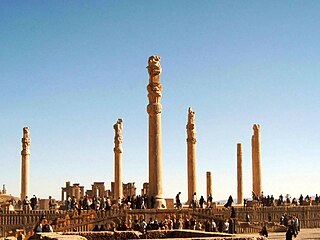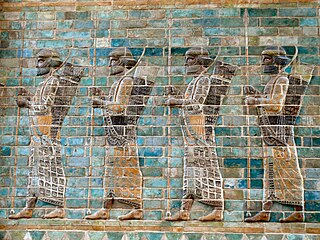
Persepolis was the ceremonial capital of the Achaemenid Empire. It is situated in the plains of Marvdasht, encircled by southern Zagros mountains, Fars province of Iran. It is one of the key Iranian Cultural heritages. The city of Shiraz is situated 60 km (37 mi) southwest of Persepolis. UNESCO declared the ruins of Persepolis a World Heritage Site in 1979.

The Medes were an ancient Iranian people who spoke the Median language and who inhabited an area known as Media between western and northern Iran. Around the 11th century BC, they occupied the mountainous region of northwestern Iran and the northeastern and eastern region of Mesopotamia in the vicinity of Ecbatana. Their consolidation in Iran is believed to have occurred during the 8th century BC. In the 7th century BC, all of western Iran and some other territories were under Median rule, but their precise geographic extent remains unknown.

Ecbatana was an ancient city and the capital of the Median Empire, making it the first capital of Iran. It later became the summer capital of the Achaemenid and Parthian Empires. It was also an important city during the Seleucid and Sasanian empires. It is believed that Ecbatana is located in the Zagros Mountains, the east of central Mesopotamia, on Hagmatana Hill. Ecbatana's strategic location and resources probably made it a popular site even before the 1st millennium BC. Along with Athens in Greece, Rome in Italy and Susa in Khuzestan, Ecbatana is one of the few ancient cities in the world that is still alive and important, representing the current-day Hamadan.

Pasargadae /pə'sɑrgədi/ was the capital of the Achaemenid Empire under Cyrus the Great. Today it is an archaeological site located just north of the town of Madar-e-Soleyman and about 90 kilometres (56 mi) to the northeast of the modern city of Shiraz. It is one of Iran's UNESCO World Heritage Sites. It is considered to be the location of the Tomb of Cyrus, a tomb previously attributed to Madar-e-Soleyman, the "Mother of Solomon". Currently it is a national tourist site administered by the Iranian culture of world heritage.
Tushhan was a Neo-Assyrian provincial capital in the upper Tigris region. It was rebuilt by the ruler Ashurnasirpal II and survived until the end of the Neo-Assyrian period around 611 BC.

Apadana is a large hypostyle hall in Persepolis, Iran. It belongs to the oldest building phase of the city of Persepolis, in the first half of the 6th century BC, as part of the original design by Darius the Great. Its construction was completed by Xerxes I. Modern scholarship "demonstrates the metaphorical nature of the Apadana reliefs as idealised social orders".

Ernst Emil Herzfeld was a German archaeologist and Iranologist.

Erich Friedrich Schmidt was a German and American-naturalized archaeologist, born in Baden-Baden. He specialized in Ancient Near East Archaeology, and became professor emeritus at the Oriental Institute of the University of Chicago. He was also a pioneer in using aerial photography in archaeological research.

Persian wine, also called May, Mul, and Bâdah, is a cultural symbol and tradition in Iran, and has a significant presence in Iranian mythology, Persian poetry and Persian miniatures.

Godin Tepe is an archaeological site in western Iran, located in the valley of Kangavar in Kermanshah province. The importance of the site may have been due to its role as a trading outpost in the early Mesopotamian trade networks.

Alireza Shapour Shahbazi was a prominent Persian archaeologist, Iranologist and a world expert on Achaemenid archaeology. Shahbazi got a BA degree in and an MA degree in East Asian archaeology from SOAS. Shahbazi had a doctorate degree in Achaemenid archaeology from University of London. Alireza Shapour Shahbazi was a lecturer in Achaemenid archaeology and Iranology at Harvard University. He was also a full professor of archaeology at Shiraz University and founded at Persepolis the Institute of Achaemenid Research in 1974. After the Islamic revolution, he moved to the US, firstly teaching at Columbia University and then later becoming a full professor of history in Eastern Oregon University.

The Department of the Middle East, numbering some 330,000 works, forms a significant part of the collections of the British Museum, and the world's largest collection of Mesopotamian antiquities outside Iraq. The collections represent the civilisations of the ancient Near East and its adjacent areas.

Athura, also called Assyria, was a geographical area within the Achaemenid Empire in Upper Mesopotamia from 539 to 330 BC as a military protectorate state. Although sometimes regarded as a satrapy, Achaemenid royal inscriptions list it as a dahyu, a concept generally interpreted as meaning either a group of people or both a country and its people, without any administrative implication.

Achaemenid architecture includes all architectural achievements of the Achaemenid Persians manifesting in construction of spectacular cities used for governance and inhabitation, temples made for worship and social gatherings, and mausoleums erected in honor of fallen kings. Achaemenid architecture was influenced by Mesopotamian, Assyrian, Egyptian, Elamite, Lydian, Greek and Median architecture. The quintessential feature of Persian architecture was its eclectic nature with foreign elements, yet producing a unique Persian identity seen in the finished product. Achaemenid architecture is academically classified under Persian architecture in terms of its style and design.

Shahrokh Razmjou is an Iranian archaeologist and historian, specializing in Achaemenid Archaeology and History. He received his PhD in Achaemenid Archaeology at the University of London. He established the Inscriptions Hall (1998–1999) and the Centre for Achaemenid Studies (2001) at the National Museum of Iran. He was curator of Ancient Iran in the Department of the Middle East, British Museum (2009–2012) and during this time, he produced a new updated translation of the text on the Cyrus Cylinder from Babylonian to Persian. He also excavated the ancient man-made caves of Niyasar, Kashan. He is currently teaching at the Department of Archaeology, University of Tehran.
Yarim Tepe is a Neolithic settlement in the eastern Gorgan plain, Golestan Province. It is located near Gonbad-e Kavus. This ancient settlement played a big role in establishing the cultural chronology of the neolithic period in Central Asia.
Tell Madhur is a tell, or archaeological settlement mound, in Diyala Governorate (Iraq). The site was excavated due to it being flooded by the reservoir created by the Hamrin Dam. Madhur is best known for its particularly well-preserved Ubaid house. A significant Early Dynastic occupation, consisting of a rounded building typical for the Hamrin region at the time, has also been attested at Madhur.

Media was a political entity centered in Ecbatana that existed from the 7th century BCE until the mid-6th century BCE and is believed to have dominated a significant portion of the Iranian plateau, preceding the powerful Achaemenid Empire. The frequent interference of the Assyrians in the Zagros region led to the process of unifying the Median tribes. By 612 BCE, the Medes became strong enough to overthrow the declining Assyrian Empire in alliance with the Babylonians. However, contemporary scholarship tends to be skeptical about the existence of a united Median "kingdom" or "state", at least for most of the 7th century BCE.














